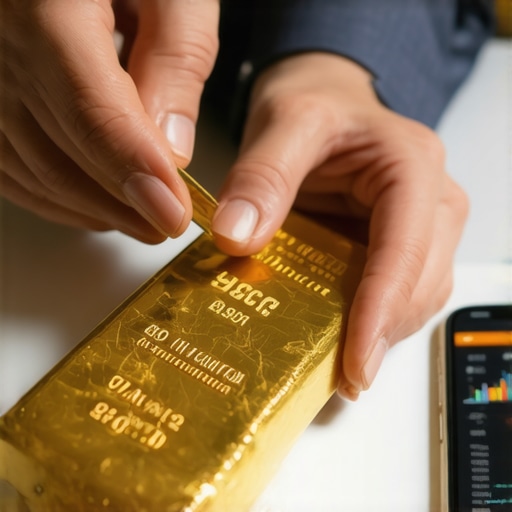Embarking on Your Gold IRA Journey: Why Now Is the Time to Act
In an era marked by economic uncertainty and fluctuating markets, diversifying your retirement portfolio with a Gold IRA offers a compelling hedge against inflation and currency devaluation. Unlike traditional IRAs, a Gold IRA allows you to hold physical precious metals, providing tangible security and long-term stability. If you’re contemplating how to fortify your retirement savings with gold, this guide offers a meticulous, step-by-step approach to starting a Gold IRA today, demystifying the process while highlighting critical considerations.
Unlocking the Gold IRA Advantage: More Than Just a Safe Haven
Gold IRAs are not merely about owning gold; they represent a strategic asset allocation tool. By including gold, you can mitigate risks associated with stock market volatility and inflationary pressures. The Internal Revenue Service (IRS) permits specific gold and precious metals to be held in these accounts, subject to purity and storage requirements, ensuring that your investment complies with regulatory standards. This unique investment vehicle is especially vital for investors seeking to preserve purchasing power over decades.
Step 1: Selecting a Reputable Gold IRA Custodian
The foundation of a successful Gold IRA begins with choosing a trusted custodian. Custodians manage your account and ensure compliance with IRS rules. Look for firms with a proven track record, transparent fee structures, and strong customer service. It is prudent to consult resources such as this ultimate guide to Gold IRA benefits to evaluate custodians effectively.
Step 2: Opening and Funding Your Gold IRA Account
Once you’ve identified a custodian, opening your IRA is straightforward. You can fund the account via direct contributions, transfers from existing IRAs, or rollovers from 401(k)s. Rollovers are a popular choice, allowing you to convert traditional retirement funds into precious metals without tax penalties if done correctly. Ensure you understand the timelines and documentation required to avoid inadvertent tax consequences.
Step 3: Choosing the Right Precious Metals for Your IRA
Not all gold products qualify for IRA inclusion. The IRS mandates specific standards for purity and form, including certain gold coins and bars. Popular options include American Gold Eagles, Canadian Gold Maple Leafs, and gold bars from accredited refiners. Balancing between coins and bars depends on your investment goals and liquidity preferences. For detailed options, explore guidance on selecting gold coins and tips for buying gold bars safely.
Step 3.1: How Do IRS Regulations Influence Your Gold IRA Choices?
Understanding IRS regulations is pivotal. Your gold must meet minimum fineness standards (usually .995 for bars and .9167 for coins) and be stored in an IRS-approved depository. These rules ensure your investment’s legitimacy and protect your tax advantages. Non-compliance can lead to penalties, so working closely with your custodian to verify eligible metals is essential.
Step 4: Secure Storage and IRS-Approved Depositories
Physical gold in an IRA must be stored in a secure, IRS-approved facility rather than at home. These depositories provide insured, climate-controlled environments, minimizing risks of theft or damage. Your custodian typically facilitates storage arrangements, and understanding fees involved is crucial for transparent cost management.
Step 5: Managing and Monitoring Your Gold IRA Investment
Starting a Gold IRA is only the beginning. Active management involves tracking gold market trends, understanding geopolitical factors influencing prices, and periodically rebalancing your portfolio. For ongoing education, consult authoritative analyses like gold market analysis and key trends to stay informed.
Engage with the Gold IRA Community: Share Your Experiences and Questions
Embarking on a Gold IRA can be complex, but you’re not alone. Share your journey, ask questions, or discuss strategies with fellow investors to deepen your understanding and make informed decisions. Your participation helps build a knowledgeable community navigating retirement security through precious metals.
For comprehensive insights on opening your first Gold IRA and maximizing its benefits, visit our detailed beginner’s guide to Gold IRA accounts.
Source: IRS Official Guidelines on Rollovers
Refining Your Gold IRA Strategy: Navigating Market Volatility with Expertise
While initiating a Gold IRA lays a solid foundation for retirement security, mastering its ongoing management is critical to maximizing returns and mitigating risks. Effective Gold IRA management involves not only monitoring price fluctuations but also understanding macroeconomic indicators, geopolitical events, and central bank policies that influence gold prices. As markets become increasingly complex in 2025, investors must adopt a proactive approach to portfolio adjustments.
Diversification Within Your Gold IRA: Beyond Physical Gold
Though physical gold bars and coins remain the cornerstone of Gold IRAs, diversifying within your precious metals portfolio can enhance growth potential and reduce risk. Consider including other IRS-approved metals such as silver, platinum, and palladium, which can provide complementary performance during different market cycles. For a comprehensive understanding of diversification benefits, explore our best gold investment strategies to maximize returns in 2025.
How Can Investors Balance Liquidity and Safety in Gold IRA Allocations?
One of the nuanced challenges in Gold IRA management is striking the right balance between liquidity and security. Physical gold offers tangible safety but can be less liquid compared to gold ETFs or mutual funds. These financial instruments allow easier portfolio rebalancing and quick response to market movements but lack the physical asset’s intrinsic security. Allocating a portion of your IRA into top gold ETFs and mutual funds can offer flexibility while maintaining exposure to the precious metals market.
Capitalizing on Market Insights: Leveraging Expert Gold Market Analysis
Staying informed through expert market analysis is indispensable. Regularly consulting trusted sources allows investors to anticipate price trends driven by supply-demand dynamics, inflation expectations, and currency valuations. For example, the World Gold Council provides in-depth data and forecasting models that can enhance decision-making. According to the World Gold Council’s latest research on gold demand trends, shifts in emerging markets and central bank activities are pivotal in shaping prices.
Tax Implications and Compliance: Staying Ahead of Regulatory Changes
Beyond investment strategy, remaining compliant with evolving IRS regulations is essential to preserving the tax advantages of your Gold IRA. Recent updates may affect contribution limits, withdrawal rules, and reporting requirements. Collaborating closely with your custodian ensures adherence to these regulations, preventing costly penalties. For a detailed overview, review the IRS guidelines and consult with financial advisors specialized in precious metals IRAs.
Engage with the Community: Share Your Gold IRA Management Experiences
Experienced investors understand the value of peer insights. We encourage readers to share their Gold IRA management strategies, challenges faced, and tips for success in the comments section below. Engaging in this dialogue not only enriches your knowledge but also fosters a robust community committed to securing retirement through precious metals.
To deepen your expertise, consider reading our comprehensive master gold trading techniques and beat market challenges guide.
Source: World Gold Council – Gold Demand Trends
Strategic Asset Allocation: Integrating Gold IRAs with Broader Retirement Portfolios
While Gold IRAs provide a robust hedge against inflation and economic volatility, sophisticated investors recognize the importance of integrating these assets seamlessly within a diversified retirement portfolio. A nuanced approach involves calibrating the allocation percentage of gold relative to equities, bonds, and alternative investments to optimize risk-adjusted returns over the long term. Experts often recommend maintaining a gold allocation between 10% to 20%, but this should be tailored based on individual risk tolerance, retirement horizon, and macroeconomic outlook.
Moreover, dynamic asset allocation strategies that adjust gold exposure in response to leading economic indicators—such as real interest rates, currency strength, and geopolitical risks—can significantly enhance portfolio resilience. For example, during periods of rising inflation expectations or geopolitical tensions, increasing gold holdings may serve as a tactical shield, whereas in stable growth phases, reallocating toward growth assets might be preferable.
Leveraging Sophisticated Analytical Tools for Gold IRA Management
Modern portfolio management transcends simple buy-and-hold strategies. Utilizing advanced analytical tools like Monte Carlo simulations, Value at Risk (VaR) models, and scenario stress testing empowers investors to understand potential portfolio outcomes under varying market conditions. These methodologies allow for comprehensive assessment of tail risks and systemic vulnerabilities impacting gold and other precious metals within IRAs.
In addition, sentiment analysis derived from futures market positioning and central bank activity reports can provide early warning signals of price inflection points. Integrating these data-driven insights with fundamental analysis—such as mining production costs and demand shifts in emerging markets—facilitates a holistic investment approach.
What Are the Complex Tax Considerations When Liquidating Gold IRA Assets?
Liquidating assets from a Gold IRA involves intricate tax implications that extend beyond standard IRA distributions. Distributions taken before age 59½ may incur a 10% early withdrawal penalty in addition to ordinary income tax. Furthermore, specific IRS rules govern the valuation and reporting of precious metals, requiring accurate documentation of fair market value at distribution.
Investors must also be cognizant of Required Minimum Distributions (RMDs) starting at age 73, which can compel liquidation of physical gold holdings potentially at suboptimal market conditions. Strategic planning with tax professionals familiar with precious metals IRAs is essential to navigate these complexities and minimize tax liabilities effectively.
Innovations in Secure Gold IRA Storage: Blockchain-Enabled Custodianship
Recent advancements in custody solutions are revolutionizing the storage and verification of physical gold in IRAs. Blockchain technology is being leveraged to create immutable digital records of gold provenance, ownership, and transaction history, enhancing transparency and reducing fraud risk.
Some custodians now offer tokenized gold assets that represent physical holdings securely stored in IRS-approved depositories. This innovation not only facilitates streamlined audits and compliance verification but also opens pathways for increased liquidity without compromising security. Investors interested in cutting-edge storage solutions should inquire about custodians integrating blockchain-enabled asset tracking.
Engage with Expert Gold IRA Consultants to Tailor Your Strategy
Given the increasing complexity of managing Gold IRAs amid evolving regulations and market dynamics, collaboration with specialized financial advisors is invaluable. Expert consultants provide bespoke portfolio construction, tax optimization strategies, and ongoing market intelligence tailored to individual retirement goals.
Explore our expert consultancy services and deepen your mastery of Gold IRA management by visiting our dedicated advisory portal.
Source: IRS – Required Minimum Distributions (RMDs) Guidelines
Decoding Multi-Layered Taxation Nuances in Gold IRA Distributions
Beyond foundational tax obligations, liquidating assets from a Gold IRA demands a sophisticated understanding of nuanced IRS stipulations. Investors must navigate early withdrawal penalties, which impose an additional 10% charge on distributions before age 59½, alongside standard income tax. Moreover, the valuation of physical gold at distribution necessitates precise fair market value assessment, as mandated by the IRS, to ensure accurate reporting and compliance.
Compounding these considerations, Required Minimum Distributions (RMDs) commencing at age 73 introduce forced liquidation risks, potentially compelling sales during adverse market conditions. Strategic tax planning with professionals specializing in precious metals IRAs is paramount to orchestrate timing and minimize fiscal impact effectively.
Blockchain-Driven Custodianship: The Vanguard of Secure Gold IRA Storage
Emerging blockchain applications are transforming traditional custodial paradigms by enabling immutable, verifiable digital ledgers for gold provenance and ownership. This technological innovation enhances transparency and curtails fraud, providing an unprecedented level of security for IRA-held physical metals.
Tokenization of physical gold assets allows seamless integration with IRS-approved depositories while facilitating liquidity avenues previously unavailable to conventional storage methods. Such custodianship models are pioneering a new era of compliance efficiency and investor confidence, warranting consideration by discerning Gold IRA investors.
How Can Integrating Blockchain Technology Mitigate Risks in Gold IRA Custody?
Integrating blockchain technology in Gold IRA storage mitigates risks by establishing tamper-proof records of ownership and transaction histories, thereby reducing fraud and enhancing auditability. This digital ledger system empowers investors and custodians with real-time verification capabilities, streamlining compliance processes with IRS regulations. Additionally, tokenized gold holdings enable fractional ownership and improved liquidity without compromising asset security, bridging a critical gap between physical asset safety and market responsiveness.
Engage with Expert Gold IRA Advisory Services for Tailored Portfolio Optimization
Given the intricate interplay between evolving market dynamics, regulatory frameworks, and technological advancements, partnering with specialized consultants has become indispensable. Expert advisors deliver bespoke asset allocation strategies, tax optimization frameworks, and continuous market intelligence tailored to individual retirement objectives.
Unlock unparalleled expertise and future-proof your retirement portfolio by exploring our dedicated Gold IRA consulting services portal.
Source: IRS – Required Minimum Distributions (RMDs) Guidelines
Frequently Asked Questions (FAQ)
What is a Gold IRA and how does it differ from a traditional IRA?
A Gold IRA is a self-directed Individual Retirement Account that allows investors to hold physical precious metals such as gold, silver, platinum, and palladium, unlike traditional IRAs which typically invest in stocks, bonds, or mutual funds. This type of IRA offers a tangible asset hedge against inflation and market volatility while adhering to IRS regulations on purity and storage.
Which gold products qualify for inclusion in a Gold IRA?
The IRS mandates specific purity standards for metals held in a Gold IRA: gold bars must have a minimum fineness of .995 and certain coins a minimum of .9167. Approved products include American Gold Eagles, Canadian Gold Maple Leafs, and gold bars from accredited refiners. It is crucial to verify eligibility with your custodian before purchase to maintain tax advantages.
How do IRS regulations impact the storage of Gold IRA assets?
Physical gold in a Gold IRA must be stored in an IRS-approved depository with secure, insured, and climate-controlled facilities. Storing gold at home or in personal safekeeping violates IRS rules and can result in penalties and disqualification of tax benefits. Custodians typically facilitate storage arrangements and must ensure compliance continually.
What are the tax implications when withdrawing or liquidating a Gold IRA?
Withdrawals before age 59½ usually incur a 10% early withdrawal penalty plus ordinary income tax on distributions. Required Minimum Distributions (RMDs) begin at age 73, necessitating liquidation of physical gold assets which may be subject to market risks. Accurate valuation and reporting of precious metals at distribution are essential to comply with IRS guidelines and minimize tax liabilities.
Can blockchain technology improve security and transparency in Gold IRA custody?
Yes, blockchain-enabled custodianship introduces immutable digital records of gold provenance and ownership, reducing fraud risks and enhancing auditability. Tokenization of physical gold assets facilitates fractional ownership and liquidity without compromising security, representing a groundbreaking advancement in Gold IRA storage solutions.
How should investors balance liquidity and safety within their Gold IRA portfolio?
While physical gold offers intrinsic security, it is less liquid compared to gold ETFs or mutual funds. A balanced Gold IRA might allocate a portion to gold ETFs or mutual funds to improve liquidity and enable quicker portfolio rebalancing, while maintaining physical metals for long-term stability and inflation protection.
What role do expert advisors play in managing a Gold IRA?
Specialized financial consultants provide tailored portfolio construction, tax optimization strategies, and up-to-date market intelligence. Their expertise helps investors navigate complex regulatory environments, evolving market conditions, and technological innovations, thereby maximizing retirement security and returns.
How can investors effectively integrate Gold IRAs into broader retirement portfolios?
Gold IRAs should be integrated with equities, bonds, and alternative investments to optimize risk-adjusted returns. Experts typically recommend maintaining a gold allocation between 10% to 20%, adjusting dynamically based on economic indicators like inflation, interest rates, and geopolitical risks to enhance portfolio resilience.
What advanced analytical tools can assist in Gold IRA management?
Tools such as Monte Carlo simulations, Value at Risk (VaR) models, scenario stress testing, and sentiment analysis of futures markets enable investors to evaluate potential portfolio outcomes and tail risks. Combining these methods with fundamental analysis of supply-demand dynamics offers a comprehensive strategy for managing precious metals IRAs.
Are rollovers from 401(k) plans to Gold IRAs beneficial?
Rollovers allow investors to transfer retirement funds from 401(k)s to Gold IRAs without incurring immediate tax penalties, provided IRS rules and timelines are strictly followed. This can be an effective way to diversify into physical precious metals while preserving tax-advantaged growth.
Trusted External Sources
- IRS Official Retirement Plans Guidelines (https://www.irs.gov/retirement-plans): Provides authoritative rules on rollovers, contribution limits, RMDs, and compliance requirements critical for Gold IRA investors.
- World Gold Council (https://www.gold.org): Offers comprehensive data, research, and market analysis on global gold demand trends, supply factors, and investment insights essential for informed Gold IRA management.
- SEC (U.S. Securities and Exchange Commission) (https://www.sec.gov): For regulatory guidance on gold ETFs, mutual funds, and investment products related to precious metals within retirement accounts.
- National Retirement Planning Coalition (https://www.nrpc.org): Provides educational resources and best practices on integrating alternative assets like gold into diversified retirement portfolios.
- Financial Industry Regulatory Authority (FINRA) (https://www.finra.org): Offers investor alerts, broker-dealer information, and insights on risks associated with precious metals investments.
Conclusion
Gold IRAs represent a sophisticated and strategic retirement investment vehicle, offering protection against inflation, market volatility, and currency risks through the ownership of physical precious metals. Successful navigation requires a thorough understanding of IRS regulations, careful selection of custodians and eligible metals, secure storage solutions, and proactive portfolio management enhanced by advanced analytical tools.
Innovations such as blockchain-enabled custodianship and expert advisory services further empower investors to optimize Gold IRA performance and compliance. Integrating gold thoughtfully within a broader retirement portfolio, balancing liquidity with security, and staying abreast of tax implications are essential for maximizing long-term benefits.
We encourage readers to apply these expert insights to fortify their retirement strategies, engage with the community to share experiences, and explore related expert resources to deepen their knowledge. Your journey toward a secure and resilient retirement portfolio begins with informed decisions today.










